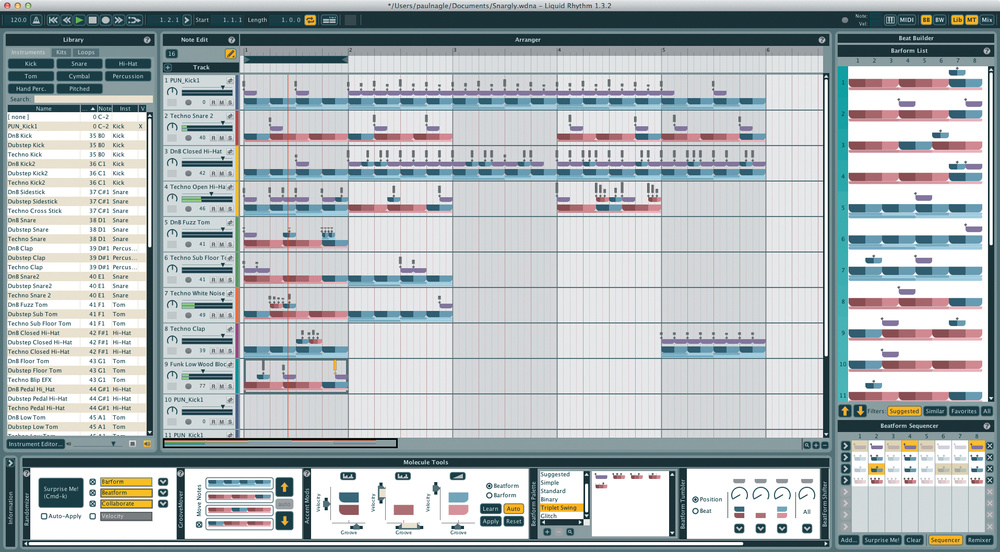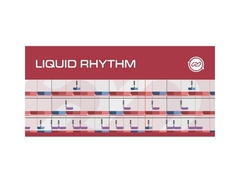
I really started to hit my stride with Liquid Rhythm when using it as a Max4Live MIDI effect. The shade of each colour is another layer of grouping, which allows you to tailor the velocities of the notes in each shade, or the groove offset. With the timing in place, grey diamonds above each BarForm slice represent note events, and the grey bar above each note denotes its velocity. Above that are the BeatForms, which are smaller slices within those 1/8th divisions - they can be a simple 1/8th-long slice (purple), two 1/16th slices, triplets, or even up to six slices per division for those super-fast glitches. The bottom row is the BarForm, which breaks up the bar into 1/8th notes, grouped into either clumps of two (blue) or three (red). And a drag’n’drop style MIDI export function is provided for arranging patterns you create within DAW tracks. This can aid in finessing the results of randomly-spawned patterns. Of course, if you want to manually sculpt your beats, you can engage Drawing or Painting mode to insert notes or BeatForms directly on the canvas. All the parameters can be MIDI mapped for mouse-free interaction. If your beat’s still lacking magic, Molecule Tools can add randomisation and dynamic accent/groove functions via the Randomizer, GrooveMover, Accent Mods, BeatForm Palette, BeatForm Tumbler, and BeatForm Shifter.

And the Maps present palettes of 256 BeatForms/BarForms, organised by increasing complexity, that may be dragged onto the canvas. The BeatWeaver basically lets you dial in (with a pot) the complexity of each BeatForm, while keeping the others in the measure locked in. Once you’ve selected a ballpark BarForm, you can use the BeatForm Sequencer to add, subtract or replace note clusters in the current measure.ĭelving further into this new mode of beat-making, you can also use the BeatWeaver and circular BarForm/BeatForm Maps to construct beats. The selected instrument type determines the initial palette of suggested BarForms. When opened as a plug-in, Liquid Rhythm’s Library appears on the left the Arranger, Mixing panel, and Molecule Tools down the centre and the Beat Builder to the right.Īfter loading a kit from the Library, you create beats by clicking on an empty measure on the Arranger canvas and selecting a BarForm from the Beat Builder. The Instrument Editor allows you to create velocity-switched, multi-sampled instruments. Liquid Rhythm is best considered a specialised sequencer for the other drum instruments in your DAW.

It’s possible to build kits from scratch using your own drum samples, however don’t expect more than a basic multi-sample player since there are no synthesis functions. The Library also contains 769 loops, which may serve as an easy starting point for beginners.
WAVEDNA LIQUID RHYTHM FREE
A mere four drum kits are preloaded (expandable to 12 via free download), built from 200+ instruments comprising velocity switched multi-samples. It’s clear the sample player is not the focus here. Both modes include a built-in drum sample player, but when opened as a Max4Live device it only displays the sequencer, relying on the user to insert a Drum Rack after it to provide sounds - a preferable option for anyone using their own drum kits. Liquid Rhythm can be invoked as a standalone instrument or DAW plug-in (AU/VST/RTAS). It’s all based around WaveDNA’s Molecule system, which presents MIDI in a whole new way. WaveDNA’s Liquid Rhythm is a rhythm sequencer that - rather than plotting in individual notes into a piano roll or sequencer - cheats for you and puts in note clusters.

Liquid Rhythm breaks beats down to the molecular level for deep-tissue manipulation.Īlthough I’ve developed dexterous finger drumming skills over the years, beat composition tools have become a gateway to more exotic grooves I’d never play habitually. Liquid Rhythm hosted as a Max4Live device inside Ableton Live allowing dynamic editing of Live’s MIDI Clips.


 0 kommentar(er)
0 kommentar(er)
